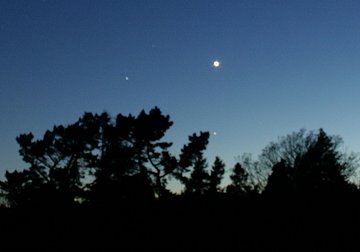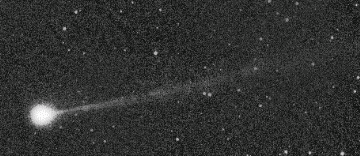 Where's Saturn? Is that a UFO--or the ISS? What's the name of that star? Get the answers from mySKY--a fun new astronomy helper from Meade. . Where's Saturn? Is that a UFO--or the ISS? What's the name of that star? Get the answers from mySKY--a fun new astronomy helper from Meade. . AURORA WATCH: A solar wind stream is buffeting Earth's magnetosphere, but so far it has been too gentle to spark geomagnetic storms. Bright auroras are unlikely tonight. CELESTIAL TRIANGLE: Set your alarm. For the next few mornings just before dawn you can see a fantastic celestial triangle rising in the eastern sky: map. The corners are Venus, Saturn and the bright star Regulus: 
Photo details: Canon 400D, ISO 400, 30 seconds
"It was worth waking up for," says William Connell who sends this picture from his backyard in Springfield, New Zealand. "I thought I would share the moment in case it happened to early for some." more images: from Scott Batson of Burke County, North Carolina; from Valter Binotto of Possagno, Italy; COMET LONEOS: Comet LONEOS (C/2007 F1) is plunging toward the sun and solar heating is doing its work: pieces of the 8th-magnitude comet are boiling off. "We were surprised to see blobs moving in the tail," report Filipe Alves, Jan Lameer and Jose Ribeiro at the AstroQueyras Observatory in the French Alps. This 24-minute time-lapse movie shows the view through the observatory's 8-inch telescope on Oct. 12th: 
Comet LONEOS makes its closest approach to the sun--just outside the orbit of Mercury--on Oct. 29th. At that time it may become faintly visible to the unaided eye, a 4th magnitude fuzzball with an increasingly active tail. Amateur astronomers, ready your telescopes! [sky map] [ephemeris] [3D orbit] More: "This comet is so close to the horizon, it is almost too low for my equipment," says astrophotographer Mike Holloway of Van Buren, Arkansas. "How low? I ask my neighbor across the field to keep his cows penned up so they don't block the view. Well maybe not quite that bad! I did manage to capture this image on Oct. 11th using a 5-inch refracting telescope."
October 2007 Aurora Gallery
[September Aurora Gallery] [Aurora Alerts] | 
